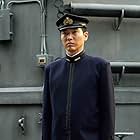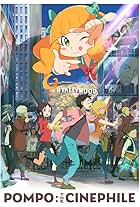IMDb RATING
7.1/10
2.6K
YOUR RATING
A cursed dancer and a musician stun society with electrifying concerts in this animated rock opera.A cursed dancer and a musician stun society with electrifying concerts in this animated rock opera.A cursed dancer and a musician stun society with electrifying concerts in this animated rock opera.
- Awards
- 3 wins & 12 nominations
Mirai Moriyama
- Tomona
- (voice)
Kenjirô Tsuda
- Inu-ô no chichi
- (voice)
Joshua Waters
- Inu-Oh
- (English version)
- (voice)
Sena Bryer
- Tomona
- (English version)
- (voice)
Cory Yee
- Shogun Yoshimitsu Ashikaga
- (English version)
- (voice)
Jason Marnocha
- Inu-oh's Father
- (English version)
- (voice)
Keythe Farley
- Tomona's Father
- (English version)
- (voice)
Holden Thomas
- Inu-Oh (Teen)
- (English version)
- (voice)
Jonathan Leon
- Tomona (Teen)
- (English version)
- (voice)
Carter Young
- Tomona (Child)
- (English version)
- (voice)
Max Lamberg
- Fujiwaka
- (English version)
- (voice)
Anjali Kunapaneni
- Additional Voices
- (English version)
- (voice)
Rene Mujica
- Taniichi
- (English version)
- (voice)
Keone Young
- Teichii
- (English version)
- (voice)
- Directors
- Writers
- All cast & crew
- Production, box office & more at IMDbPro
Storyline
Did you know
- TriviaMasaaki Yuasa took the music of bands Foreigner, Queen and Deep Purple as a huge inspiration for this movie's music.
- ConnectionsReferenced in AniMat's Crazy Cartoon Cast: The Awards are Approaching (2022)
Featured review
"The Gion Shoja bells echo the impermanence of all things." Though these words never appear in the film itself, they throb through the subtext like a living pulse. The Genpei War left such a deep impression on Japanese history that, as is featured in one of the early scenes, a species of crab found in the Setouchi Inland Sea, whose back bears a haunting resemblance to a human face, is referred to as the "Heike crab," in honor of the majority of remaining Heike who perished at Dan-no-ura. The stunning animation and the subversive, transformatively expressive plot is more than enough to draw you in even without the historical context, and knowledge of the war is not essential to the plot, but it is important to understand that the struggle of the two lead characters is layered with more than just their own interpersonal conflicts.
In the great tradition of noh on which the lead character, Inu-oh's story arc is ostensibly based, the film intentionally uses anachronistic, modern music to show the revolutionary effect that noh performers like Inu-oh would have had in their own time. Noh is an art form that exists purely based on reproduction of older works, with added music and abstraction, not to tell a story so much as to work through trauma and to share transcendent moments of universal human emotion. Inu-oh and Tomona, the blind biwa-player he befriends, borrow the Tale of the Heike in order to exorcise their own demons and discover their true selves. Indeed, Inu-oh's physical transformation is symbolic of the power of art to transform us into our true selves through self-expression.
In fact, the film has arguably only two points worthy of criticism. First, a lack of emphasis on the original Tale of the Heike. Especially for those not already familiar with the text - and in modern times, those who know it well are few and far between even in Japan - the emotional weight of those angry spirits supposedly in need of salvation would have added much more texture to the plot and to the significance of their quest.
Second, the film has a subtle tendency to be both ableist and homophobic. The muddled metaphor of Inu-oh becoming physically more stereotypical through good deeds suggests that he could not have become famous with his disability as it was, even though he is shown to be a superior performer precisely because of it, not in spite of it. Alternatively, it suggests that he could not have become famous without stereotypical good looks. The homophobia is more subtle, but partly unavoidable in the historical context, given that master-pupil and patron-performer relationships in premodern Japan frequently contained an expectation of sexual favors, including pederasty as in ancient Greece. Well deserving of criticism in a modern context to be sure, but considering that implied pedophilia (by a villain as well) is the only homosexuality represented - especially given that the two lead characters share a bond which might be considered romantic if only the creators had been bold enough to include physical representation of it - the overall impression is a very modern sense that homosexuality is not something pure enough to have been a part of this artistic interpretation of a deeply inspiring historical figure.
These things do detract from the film on an initial viewing, but the powerful soundtrack, the entrancing visuals, and the both tragic and uplifting story of the two leads have kept me almost vibrating from excitement ever since seeing it roughly a month ago. Although it hasn't been released in the US yet, I must say it is already highly underrated and an instant classic.
In the great tradition of noh on which the lead character, Inu-oh's story arc is ostensibly based, the film intentionally uses anachronistic, modern music to show the revolutionary effect that noh performers like Inu-oh would have had in their own time. Noh is an art form that exists purely based on reproduction of older works, with added music and abstraction, not to tell a story so much as to work through trauma and to share transcendent moments of universal human emotion. Inu-oh and Tomona, the blind biwa-player he befriends, borrow the Tale of the Heike in order to exorcise their own demons and discover their true selves. Indeed, Inu-oh's physical transformation is symbolic of the power of art to transform us into our true selves through self-expression.
In fact, the film has arguably only two points worthy of criticism. First, a lack of emphasis on the original Tale of the Heike. Especially for those not already familiar with the text - and in modern times, those who know it well are few and far between even in Japan - the emotional weight of those angry spirits supposedly in need of salvation would have added much more texture to the plot and to the significance of their quest.
Second, the film has a subtle tendency to be both ableist and homophobic. The muddled metaphor of Inu-oh becoming physically more stereotypical through good deeds suggests that he could not have become famous with his disability as it was, even though he is shown to be a superior performer precisely because of it, not in spite of it. Alternatively, it suggests that he could not have become famous without stereotypical good looks. The homophobia is more subtle, but partly unavoidable in the historical context, given that master-pupil and patron-performer relationships in premodern Japan frequently contained an expectation of sexual favors, including pederasty as in ancient Greece. Well deserving of criticism in a modern context to be sure, but considering that implied pedophilia (by a villain as well) is the only homosexuality represented - especially given that the two lead characters share a bond which might be considered romantic if only the creators had been bold enough to include physical representation of it - the overall impression is a very modern sense that homosexuality is not something pure enough to have been a part of this artistic interpretation of a deeply inspiring historical figure.
These things do detract from the film on an initial viewing, but the powerful soundtrack, the entrancing visuals, and the both tragic and uplifting story of the two leads have kept me almost vibrating from excitement ever since seeing it roughly a month ago. Although it hasn't been released in the US yet, I must say it is already highly underrated and an instant classic.
- kaizoku-gari87
- Jul 7, 2022
- Permalink
- How long is Inu-oh?Powered by Alexa
Details
Box office
- Gross US & Canada
- $351,558
- Opening weekend US & Canada
- $191,004
- Aug 14, 2022
- Gross worldwide
- $484,127
- Runtime1 hour 38 minutes
- Color
- Aspect ratio
- 2.39 : 1
Contribute to this page
Suggest an edit or add missing content
































